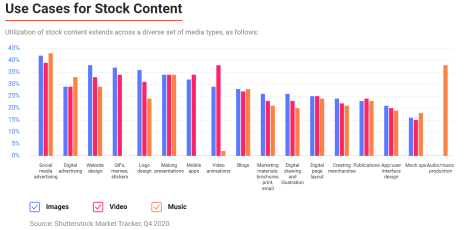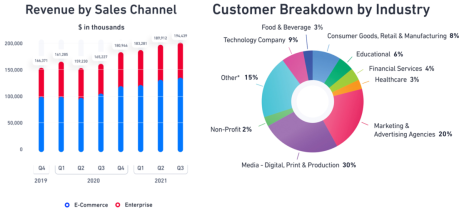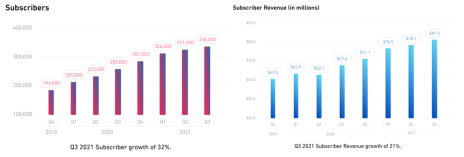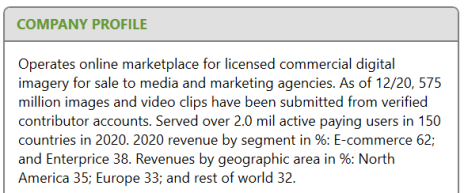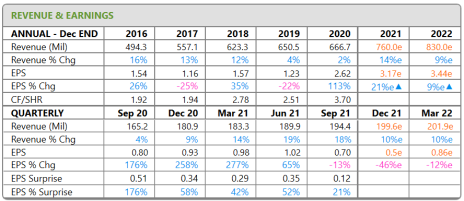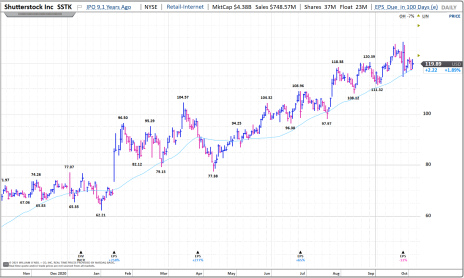Recently, we’ve been adding very aggressive, high-growth names. These potential moonshots are a lot of fun to research and buy, but we need to maintain balance in our portfolio.
This month we’re going with more of a Steady Eddie-type, a small-cap company with a measured growth profile that features sustainable top line growth, significant EPS, and enough cash flow to fund both dividend payments and share repurchases.
I think in a few years we’ll look back and say it was one of the better investment decisions we made in 2021.
Enjoy!
Company Overview
The Big Idea
In the late 1990s Matt and Andy Wisdom were living in New Orleans, producing 3D animation for TV commercials. On a project for a company named Radiophone they needed animated cellphones playing basketball. They spent $15,000 out of a $25,000 budget to design those models in house.
That disconnect sparked a simple question: why was there no way for graphic artists to share their models so people could buy and use them?
In 2000 the brothers formed a company, TurboSquid. It was an online marketplace for sharing 3D models over the internet. Just a few years later they had major clients, including Apple (AAPL), Pixar, ABC News and The New York Times.
At roughly the same time a photographer and programmer named Jon Oringer saw a similar gap in the market for stock photos. He uploaded 30,000 of his own pictures, created a marketplace, and started charging $49 a month for unlimited downloads.
He named his company Shutterstock.
Both of these companies were born out of a need to solve the same basic problem. People and businesses needed content to build out web pages, marketing materials, advertisements and films, but they didn’t have the time, expertise or budget to do it themselves.
Online marketplaces like TurboSquid and Shutterstock made it far easier, and they gave content creators a way to monetize their talents without all the hassles of creating their own platforms.
Over the last two decades the market for stock content has grown exponentially, powered by digital advertising, website proliferation, video on demand, social media and mobile device usage.
Today, businesses small and large, as well as independent creatives, are consuming stock content at a record rate. With all the content out there and the need to alter it to suit specific needs, users require platforms with tools to make searching, editing, and publishing stock content as painless as possible.
Shutterstock (SSTK), which is now publicly traded, is the way to play the trend. As a sweetener, the company has just acquired TurboSquid (as well as other, smaller players), and is building out a content platform to meet the needs of brands, businesses and media companies all over the world.
New Recommendation and Updates
The Company
Shutterstock (SSTK) has developed an online marketplace for digital commercial imagery, including photos, 3D models, video footage and music.
Its platform brings contributors and users of content together so they can supply and/or source high-quality, licensed content. The company has a market cap of $4.38 billion.
Contributors simply upload their content to Shutterstock’s web properties and earn royalties based on customer download activity.
Users of content include brands, businesses, media companies, prosumers and consumers. They can search for the content they want online, pay to license what they want, and use that content for a variety of purposes ranging from websites, marketing materials and social media posts to media productions, games and architectural renderings.
While there are other places people can source content from online, one of the reasons Shutterstock wins is because of the huge variety of content on the platform. There are over 1.9 million content contributors that have collectively added over 390 million images and over 23 million footage clips.
This is one of the largest treasure troves of content out there. And it is why Shutterstock was able to deliver 135 million downloads to customers through just the first nine months of 2021.
Beyond the variety of content on its platform, Shutterstock’s revenue mix is diversified as well. It has over 2 million active paying customers. Revenue is spread out around the globe, with 37% coming from North America, 33% coming from Europe and 30% coming from the rest of the world.
Customers fall into one of two categories; E-Commerce (64% of revenue) and Enterprise (36% of revenue).
E-commerce customers subscribe to content licenses (monthly or annual subscriptions) or pay for content on a per-download basis. The vast majority of these customers license content directly through Shutterstock’s website properties, including shutterstock.com, bigstock.com, premiumbeat.com and turbosquid.com.
Enterprise customers are larger and have unique content, licensing and workflow requirements. They include media agencies, publishers, production companies and creative service providers. These clients work with Shutterstock’s dedicated sales, service and research teams who help create and match the client with custom, on-brand content. Many pay for access to additional solutions (API platform, Shutterstock Editorial, Shutterstock Studios, etc.).
Platform & Products
At the core of Shutterstock’s platform is content.
Images: Images include photos, vectors and illustrations. They are typically used on websites, in digital and print marketing materials, in books and other publications, and in company communications.
Footage: Footage includes video clips, premium footage filmed by industry experts and cinema-grade video effects. Video is available in HD and 4K formats. It is typically used in websites, social media, marketing campaigns, and cinematic productions.
Music: Shutterstock offers a variety of music and sound effects which is used to complement images and footage.
3D: Following the February 2021 acquisition of TurboSquid, Shutterstock’s platform includes 3D models. They are typically used in advertising, gaming, media and video production, retail, education, and design and architecture.
Creative Design Software: With the September 2021 acquisition of PicMonkey Shutterstock added an online graphic design and image editing platform.
Shutterstock’s large and diverse content library and contributor network helps to create a network effect that powers customer, contributor and content growth. This growth, and the integrity of the company’s brands, is supported by tools that deliver an enjoyable user experience.
The company has developed an AI-based search engine that helps customers quickly search and curate images, footage and audio files. The user data generated from these searches continuously feeds algorithms, and recent data acquisitions will help the company build out the platform’s AI capabilities to meet the evolving demands of the market.
Shutterstock’s platform also has workflow tools, such as Shutterstock Editor and Editor Pro, that help creators quickly size, edit and enhance images for use in presentations, social media posts and advertisements. The recent PicMonkey acquisition brings in additional image editing functionality.
Finally, Shutterstock’s API infrastructure helps businesses seamlessly integrate the company’s content into their platforms. This is particularly important for Enterprise clients since content can be distributed to end users via partnerships and plug-ins with social media, software and marketing technology platforms, including certain solutions from Microsoft (MSFT), Facebook (FB), Google (GOOG), Wix.com (WIX), Apple (APPL) and Adobe (ADBE).
Acquisitions
PicMonkey In September 2021 Shutterstock acquired Washington-based PicMonkey for $110 million. PicMonkey operated an online graphic design and image editing platform that gives users – even those with limited skill levels – easy-to-use tools so they can design high-quality images.
Pattern89, Datasine & Shotzr Asset Acquisitions: In July 2021 Shutterstock purchased three artificial intelligence platforms to aid in delivering data driven insights. The total investment was $35 million and was paid for in cash.
TurboSquid: In February 2021 Shutterstock acquired Louisiana-based TurboSquid for $77.3 million. TurboSquid operates a marketplace with over a million 3D models, 2D models derived from 3D objects and a digital asset management solution. The acquisition immediately vaulted Shutterstock to the forefront of the market for sourcing 3D/2D format models.
Growth Initiatives
Deepening Customer Relationships: Following the July 2021 data acquisitions (Pattern89, Datasine, Shotzr) Shutterstock ramped up its initiative to create an AI platform, Shutterstock.AI, that offers predictive performance capabilities so clients can make more data-informed content decisions. The PicMonkey acquisition adds design, editing and collaboration tools. Taken together these initiatives (and more to come) should help Shutterstock become even more embedded in customer workflows, powering growth and customer retention.
Metaverse Build Out: As companies, including Facebook (FB), build out their online presences they need a wider variety of digital content, which Shutterstock is able to provide. The recent 3D TurboSquid acquisition is a perfect example of how Shutterstock can fulfill this need.
Dividends: Shutterstock has paid dividends totaling $0.63 through the first three quarters of 2021 and has another $0.21 dividend set to be paid on December 16. I fully expect dividend increases in the future. These payments should help the stock.
Share Buybacks: Shutterstock has had share repurchase programs in place since 2015. As of September 30, 2021 the company has $95 million remaining under the current authorization program. Year-to-date, the company has repurchased 41,900 shares at an average cost of $115.95 ($4.86 million). Expect continued purchases to help support the share price during pullbacks.
New Subscription Products (FLEX, etc.) Shutterstock introduced FLEX plans in April 2021 and then rolled out FLEX Premium in September. FLEX subscriptions offer access to royalty-free content across all categories (photos, video, music, 3D models) for up to 10 users, while the FLEX Premium offering has no restrictions or user limitations. FLEX plans have been so popular for both Enterprise and small business clients that similar plans were recently rolled out to Ecommerce clients under the FLEX 25 offering.
The Business Model
Shutterstock generates the bulk of its revenue from licensing content. Content licenses are sold either on a subscription or transaction basis. Subscriptions are either monthly or yearly and include a certain quantity of content. Transaction-based licenses mean customers simply pay per piece of content downloaded. Content contributors earn royalties (paid on a regular schedule), with the rate based on different tiers of annual licensing volume.
The Bottom Line
Shutterstock has been evolving its subscription-based pricing model by adding plans, such as FLEX, that are driving subscriber count and subscriber revenue. In recent quarters this evolution has really been kicking into gear, helping to drive growth well above that posted in 2019 and 2020.
Shutterstock’s average annual revenue growth rate was 13.7% between 2016 – 2018. Growth slowed to just 4% in 2019 and 2% in 2020, when revenue was $666.7 million. Top-line growth has been accelerating recently, and profits are settling at much higher rates too.
For example, over the first three quarters of 2021 revenue has grown by 14%, 19% and 18%. In Q3 Shutterstock’s reported $194 million in revenue was $8 million ahead of consensus expectations. TurboSquid and PicMonkey added $8.9 million, and there was a 2% headwind from foreign exchange conversions.
On the bottom line, the trend is encouraging as well. Looking back, from 2016 – 2019 annual EPS bounced around between $1.16 (2017) and $1.57 (2018). Then in 2020 EPS jumped to $2.62, a 113% increase over the $1.23 reported in 2019. With EPS of $0.70 reported in Q3 (well ahead of the $0.58 expected) Shutterstock is on pace to deliver adjusted EPS of $3.20 this year (up 20%).
Moreover, management raised full-year guidance from $740 - $750 million to $765 - $770 million. That implies roughly 15% revenue growth this year.
Other metrics look solid as well. In Q3 2021 subscriber count grew 32% to 336 million, average revenue per subscriber grew 10% to $361, and revenue per download grew 11% to $4.20. These figures exclude customers acquired through TurboSquid and PicMonkey.
This type of measured growth with profitability and significant cash flow (aiding dividends and share buybacks) should make SSTK an incredibly attractive stock to fund managers.
Risk
Competition: In the grand scheme of things, it’s not that hard to build a photo sharing marketplace. Shutterstock must keep an eye on upstart competitors. What’s more difficult is assembling the technology, data, search capabilities and huge variety of content the company has now.
Enterprise Business Growth: Revenue in the enterprise segment suffered in 2019 and 2020. While this segment is doing much better now management needs to keep their foot on the gas.
Growth Rate: SSTK is doing well now that growth is above 10% again. Consensus estimates suggest the growth rate could dip into the high single digits in 2023 and beyond. I believe the stock’s continued upward trajectory will require acquisitions, sales execution, etc. that can keep the growth rate above 10%.
Patent Infringement: In a marketplace of licensed content there is always concern of a meaningful license infringement issue.
Competition
Shutterstock competes with other content providers that include iStock (acquired by Getty Images in 2006), Stocksy United (a platform cooperative founded by iStock’s founder Bruce Livingstone), AdobeStock (ADBE), VimeoStock, Canva and Pond5. For music it competes with Universal Music Publishing Group, Sony/ATV Music Publishing and Warner Music. To some extent it also competes with Google Images, Flickr and sources of free images.
The Stock
Trading Volume: Average daily volume is 202,000 shares, or roughly $24 million at the current share price. We’re unlikely to move this stock.
Historical Price: SSTK came public at 16 back in 2012 and initially did well (was close to 100 in early-2014 as annual revenue growth was above 30%). The stock then waffled for several years as growth slowed. Things began to turn around in July 2020 when SSTK jumped over 40. On the back of solid revenue growth shares advanced through 60 (October 2020), 80 (February 2021) and 100 (June 2021). The trend has been especially consistent since May, after which the SSTK has made a series of higher highs and higher lows, with consistent rallies off the 50-day line.
Valuation & Projected Price Target: A 140 price target implies SSTK can trade up to an EV/2022 EBITDA multiple of around 22. That’s a pretty safe price target as it is in line with a peer group of stocks with similar growth and profit profiles. As always a price target is just a starting point.
Buy Range: In the near term buy up to the recent high of 128 and down to 108.5 (10% below yesterdays close). As we go forward I’ll be providing weekly updates on the buy/hold rating.
The Next Event: A $0.21 dividend is set to be paid on December 16 to shareholders of record on December 21. We don’t yet have a Q4 earnings date. Q3 earnings were just reported on October 26.
Updates on Current Recommendations
| Stock Name | Date Bought | Price Bought | Price on 11/3/21 | Profit | Rating |
| Accolade (ACCD) | 8/6/20 | 40 | 40 | 0% | Hold |
| Arena Pharmaceuticals (ARNA) | 2/2/18 | 39 | 63 | 63% | Buy |
| Avalara (AVLR) | 2/1/19 | 40 | 184 | 360% | Buy |
| Cerence (CRNC) | 10/1/20 | 50 | 113 | 127% | Hold |
| CS Disco (LAW) | 9/2/21 | 57 | 56 | -1% | Buy |
| Everbridge (EVBG) | 12/2/16 | 16 | 156 | 907% | Buy |
| Fiverr Intl (FVRR) | 3/5/20 | 32 | 165 | 411% | Buy |
| Inspire Medical (INSP) | 10/4/19 | 59 | 269 | 359% | Hold |
| JOANN (JOAN) | 8/6/21 | 15 | 11 | -26% | Buy |
| Kornit Digital (KRNT) | 3/4/21 | 102 | 160 | 57% | Buy |
| Rani Therapeutics (RANI) | 10/7/21 | 17 | 28 | 64% | Buy |
| Repligen (RGEN) | 11/2/18 and 12/31/18 | 59 | 292 | 394% | Hold |
| Revolve Group, Inc. (RVLV) | 4/1/21 | 46 | 76 | 67% | Hold |
| Shutterstock (SSTK) | New | — | 120 | — | Buy |
| Sprout Social (SPT) | 9/3/20 | 36 | 126 | 244% | Buy |
| Thunderbird Entertainment (THBRF, TBRD.V) | 5/6/21 | 3.8 | 3.9 | 1% | Buy |
Please email me at tyler@cabotwealth.com with any questions or comments about any of our stocks, or anything else on your mind.
Glossary
Buy means accumulate shares at or around the current price.
Hold means just that; hold what you have. Don’t buy, or sell, shares.
Sell means the original reasons for buying the stock no longer apply, and I recommend exiting the position.
Sell a Half means it’s time to take partial profits. Sell half (or whatever portion feels right to you) to lock in a gain, and hold on to the rest until another ratings change is issued.
Disclosure: Tyler Laundon owns shares in one or more of the stocks mentioned. He will only buy shares after he has shared his recommendation with Cabot Small-Cap Confidential members and will follow his rating guidelines.
The next Cabot Small-Cap Confidential issue is scheduled for December 2, 2021.

